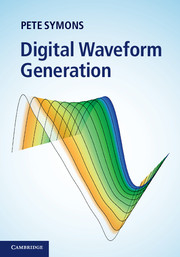Book contents
- Frontmatter
- Contents
- Preface
- Acknowledgements
- Glossary of terms
- 1 Introduction to waveform generation
- 2 The foundations of digital waveform generation
- 3 Recursive sine wave oscillators
- 4 DDS sine wave generation
- 5 DDS arbitrary waveform generation
- 6 Dynamic waveshape and spectrum control
- 7 Phase domain processing – DDS and the IDFT
- 8 Hardware implementation architectures
- 9 Digital to analogue conversion
- Index
- References
5 - DDS arbitrary waveform generation
Published online by Cambridge University Press: 05 November 2013
- Frontmatter
- Contents
- Preface
- Acknowledgements
- Glossary of terms
- 1 Introduction to waveform generation
- 2 The foundations of digital waveform generation
- 3 Recursive sine wave oscillators
- 4 DDS sine wave generation
- 5 DDS arbitrary waveform generation
- 6 Dynamic waveshape and spectrum control
- 7 Phase domain processing – DDS and the IDFT
- 8 Hardware implementation architectures
- 9 Digital to analogue conversion
- Index
- References
Summary
From sinusoidal to arbitrary waveforms
In Chapter 4 we investigated sinusoidal DDS and developed the concept of phase–amplitude mapping using a wavetable. In sinusoidal DDS, the wavetable is a lookup table that tabulates one cycle of a sine function and translates from the phase domain to the amplitude domain. In this chapter we extend this idea to the generation of non-sinusoidal waveforms where a single-cycle, periodic arbitrary waveform function is now tabulated in the wavetable. We call this method DDS arbitrary waveform generation or DDS AWG. DDS AWG is a generalisation of sinusoidal DDS that generates arbitrary waveforms with fixed waveshape and independently controlled frequency, phase offset and amplitude. Furthermore, DDS also allows independent dynamic modulation of these parameters according to a modulation waveform. However, the signal processing structure of DDS AWG is easily modified to provide smooth, parametrically controlled (i.e. time-varying) waveshape and corresponding spectrum. We consider dynamic waveshape control further in Chapter 6.
Before proceeding, several fundamental problems become evident when we move from generation of sinusoidal to arbitrary waveforms using DDS principles. These may be summarised as:
specification and tabulation of an arbitrary waveform function that is compatible with DDS requirements, as introduced in Chapter 2;
an increase in the magnitude of the amplitude error signal εa(n) as a function of waveform harmonic content, the amount of phase truncation (i.e. the number of F bits) and the phase increment φ;
the additional computational complexity of linear and higher-order phase interpolation that is required to reduce the magnitude of εa(n) and hence increase waveform SNR and SFDR;
the susceptibility to harmonic alias images in the Nyquist band when the upper waveform harmonics exceed the Nyquist frequency;
the necessity for pre-tabulation band-limiting of a wavetable function specified in the time domain (i.e. by shape) to mitigate harmonic aliasing caused by the high frequency content of any waveform discontinuities.
- Type
- Chapter
- Information
- Digital Waveform Generation , pp. 162 - 227Publisher: Cambridge University PressPrint publication year: 2013

